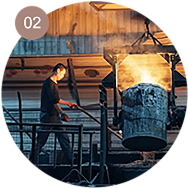
cleaning cast iron skillet
Cleaning a Cast Iron Skillet A Step-by-Step Guide
Cast iron skillets are beloved kitchen tools renowned for their durability, heat retention, and unique ability to develop a natural non-stick surface. However, one of the common concerns for new cast iron skillet owners is how to properly clean and maintain this essential cookware. Cleaning a cast iron skillet might seem daunting, but with a few straightforward techniques, you can ensure its longevity and performance. Here’s a comprehensive guide to cleaning your cast iron skillet.
Why Proper Cleaning Matters
The primary reason for maintaining your cast iron skillet is to preserve its seasoning. Seasoning is a layer of polymerized oil that creates a natural non-stick surface, protects the iron from rust, and enhances flavor over time. Improper cleaning can strip away this seasoning, leading to a rusty, sticky mess. Therefore, it’s crucial to adopt gentle techniques to preserve this seasoned layer.
Cleaning Your Skillet Step-by-Step
1. Let It Cool Down After cooking, allow your skillet to cool down gradually. Don’t submerge it in cold water while it’s still hot, as this can cause the cast iron to warp or crack.
2. Scrape Off Food Residue Once the skillet has cooled enough to handle, use a spatula or a non-metal scrubber to scrape off any stuck-on food. If necessary, you can add a bit of coarse salt as an abrasive to help remove burnt bits. The salt will act as a gentle scrub without damaging the seasoning.
3. Rinse with Warm Water Rinse the skillet under warm water. Avoid using soap, as it can break down the seasoning. If you feel the need to use soap for particularly stubborn stains, make sure it’s a mild dish soap and follow up with a re-seasoning step later.
cleaning cast iron skillet

4. Dry Thoroughly After rinsing, dry the skillet immediately with a clean cloth or paper towel. Cast iron can be prone to rust if it retains moisture, so ensuring your skillet is completely dry is crucial.
5. Reapply Oil Once the skillet is dry, apply a light coat of vegetable oil or another cooking oil to its surface using a paper towel. This process replenishes the seasoning and prevents rust. It’s essential to use just a thin layer to avoid a sticky residue.
6. Store Properly Store your cast iron skillet in a dry place. If stacking with other cookware, consider placing a paper towel between them to absorb moisture and keep the cooking surfaces scratch-free.
When to Deep Clean
If your skillet has developed a crusty buildup or has started to rust, it may require a deep clean. This process involves
- Scrubbing Use a combination of coarse salt and a little water or oil to scrub away the buildup. - Oven Restoration For severe cases, you can strip your skillet of its seasoning by placing it in a self-cleaning oven cycle or using an oven-safe method with lye. However, this should be a last resort, as it requires significant effort and care. - Re-seasoning After deep cleaning, wash your skillet, dry it thoroughly, and then re-season it by applying oil and baking it upside down in the oven at a high temperature.
Conclusion
Cleaning a cast iron skillet doesn’t have to be a chore. With proper care and techniques, you can keep your skillet in excellent condition for years to come. Remember to avoid harsh soaps, always dry it thoroughly, and regularly apply a coat of oil to maintain the seasoning. By following these tips, you can enjoy the many culinary benefits of cast iron cooking without the stress of maintaining your skillet. Happy cooking!
-
Season Cast Iron Perfectly with GPT-4 Turbo TipsNewsAug.01,2025
-
High Quality Cast Iron Cookware - Baixiang County Zhongda MachineryNewsAug.01,2025
-
Premium Cast Iron Pan: Durable & Perfect HeatNewsAug.01,2025
-
High Quality Kitchen Durable Black Round Cast Iron Cookware Pancake Crepe Pan-Baixiang County Zhongda Machinery Manufacturing Co., Ltd.NewsAug.01,2025
-
Cast Iron Cookware - Baixiang County Zhongda Machinery | Nonstick, Heat ResistanceNewsAug.01,2025
-
High Quality Kitchen Durable Black Round Cast Iron Cookware - Baixiang County Zhongda Machinery | Non-Stick, Heat Retention, DurableNewsJul.31,2025


